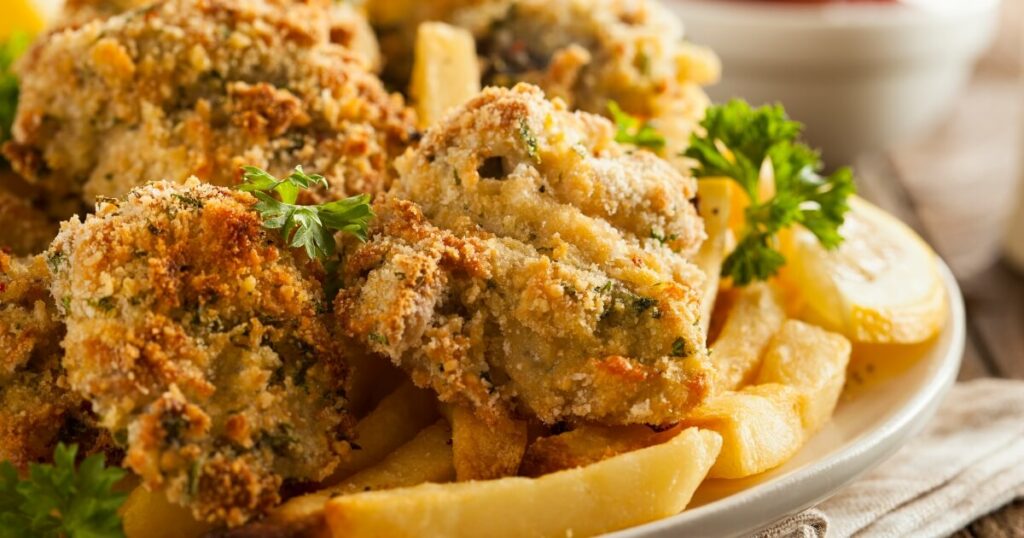There’s something about fried food that makes it irresistible and fried oysters are another food I’m always ready to eat!
The taste of fried oysters is complemented by the textures they offer. The outside is crispy from the breading and frying, while the inside remains tender and juicy. This combination of taste and texture can elevate any dish, making it a memorable meal.
In this article, we’ll explore their taste profile in more detail, discuss their texture, and even touch on the different ways they can be prepared and enjoyed.
How Do Fried Oysters Taste?
Fried oysters are a taste adventure, offering a flavor that is reminiscent of the sea. They carry the subtle saltiness of the ocean, a hint of fishiness, and a delicate flavor enhanced by the frying process.

The breading used in frying, often seasoned with herbs and spices, adds an extra layer of flavor, making each bite a delightful experience.
The texture of fried oysters is just as enticing as their taste.
The outside becomes crispy and golden brown from the frying, providing a satisfying crunch with each bite. Inside, the oyster remains soft and tender, a contrast that adds to the overall enjoyment of eating them.
What Do Fried Oysters Compare With?
- Fried Clams: Both fried oysters and fried clams have a crispy exterior and a soft interior. However, fried clams tend to have a more pronounced seafood flavor, while fried oysters have a more subtle, delicate taste.
- Fried Shrimp: Fried shrimp and fried oysters share a similar texture, with a crunchy outside and a tender inside. However, shrimp has a sweeter flavor profile, while fried oysters carry a taste of the ocean.
- Fried Calamari: Both have a crispy exterior from the frying process. Calamari, or squid, has a slightly chewier texture and a mild, slightly sweet flavor, while fried oysters are softer inside and have a more pronounced salty, ocean-like flavor.
- Fried Scallops: Scallops have a sweet, delicate flavor that is different from the briny taste of fried oysters. However, when fried, both offer a satisfying contrast between the crispy exterior and the soft, juicy interior.
- Fried Fish: Depending on the type of fish, fried fish can have a stronger or milder flavor than fried oysters. The texture of fried fish can also vary, but generally, it’s flaky inside with a crispy exterior, providing a different texture experience than the soft interior of fried oysters.
Do Fried Oysters Taste Fishy?
Fried oysters do carry a hint of a fishy taste, but it’s not overpowering. The taste is more of a subtle nod to their oceanic origins, a gentle reminder of the sea.
The frying process and the seasonings used in the breading often mellows out any strong fishy flavor, resulting in a more balanced and enjoyable taste.
If you’re sensitive to the taste of seafood, using a flavorful dipping sauce can also help to mask any fishiness.
Do Fried Oysters Smell Fishy?
When it comes to the smell, fried oysters do not have a strong fishy odor. The frying process tends to reduce any natural seafood smell, and the aroma you’re more likely to notice is that of the breading and the oil used for frying.
This appetizing scent can enhance the overall eating experience, making the fried oysters even more enticing.
However, it’s worth noting that a strong fishy smell can be a sign of not fresh oysters, so always ensure you’re using fresh oysters for the best results.
What Do Fried Oysters Look Like?
Fried oysters typically have a rounded or slightly irregular shape, depending on the natural shape of the oyster. The outside is coated in a layer of breading or batter that turns a beautiful golden brown when fried.

This exterior is often speckled with darker brown spots where the breading has crisped and caramelized in the hot oil.
Upon cutting into a fried oyster, you’ll find the interior to be a contrasting soft and creamy texture. The color of the oyster inside can vary from a light cream to a deeper grayish hue, depending on the type of oyster and its diet.
The fried oysters usually glisten with the cooking oil, adding a tempting sheen.
When arranged on a plate, perhaps with a wedge of lemon or a side of dipping sauce, fried oysters present an appetizing picture that promises a delightful culinary experience.
Should You Buy Or Make Fried Oysters Yourself?
Whether you should buy or make fried oysters yourself depends on a few factors, including your comfort level in the kitchen, the quality of the oysters available to you, and your personal taste preferences.
If you’re buying fried oysters, ensuring they’re from a reputable source is important. Look for places that specialize in seafood and have a high turnover rate, as this often means the oysters are fresher.
The fried oysters should have a golden, crispy exterior and a soft, juicy interior. They should smell fresh, not overly fishy.
Making fried oysters at home allows you to control the ingredients and the cooking process. You can choose the type of breading and seasonings and ensure the oysters are cooked to your preferred level of crispiness.
However, it’s crucial to start with fresh, high-quality oysters. They should have a clean, ocean-like smell, and their shells should be tightly closed.
Just remember, the fresher the oysters, the better the final dish will taste.
How To Make Fried Oysters Taste Good
Making delicious fried oysters starts with the quality of the oysters themselves. Fresh, high-quality oysters are key to achieving the best flavor.
The breading or batter used for frying also plays a role in the taste of fried oysters. A simple mix of flour, salt, and pepper can be used, but adding additional seasonings can elevate the flavor.
Consider incorporating spices like paprika, garlic powder, or cayenne for a bit of heat. Fresh herbs like parsley or dill can also add a nice touch.
The type of oil used for frying can also influence the taste. Neutral oils like canola or vegetable oil are usually used, but you might consider using peanut oil or even frying in a pan with a bit of butter for a richer flavor.
Cooking time is crucial. Overcooked oysters can become tough and lose their delicate flavor. It usually takes just a few minutes to achieve a golden brown, crispy exterior while keeping the inside tender and juicy.
Finally, consider the accompaniments. Fried oysters are best served with a dipping sauce, greatly enhancing their flavor. Tartar sauce, cocktail sauce, or a spicy remoulade are all popular choices.
A squeeze of fresh lemon over the top can also add a nice brightness that complements the flavor of the oysters.
By paying attention to these details, you can ensure that your fried oysters are not just good but truly delicious.
Fried Oysters FAQs
How do you cook a fried oyster?
Fried oysters are typically dredged in flour and seasonings, then dipped in beaten egg, and finally coated in breadcrumbs. They are then fried in hot oil until golden brown and crispy. It’s important not to overcook them, as this can make the oysters tough rather than tender.
Why do deep-fried oysters from restaurants taste so much better than those I make at home?
Restaurants often have access to very fresh oysters and may use special techniques or secret ingredients in their breading or batter. Additionally, they typically use commercial-grade fryers that maintain a consistent, high temperature, resulting in a perfectly crispy exterior.
Do oysters taste good?
Whether or not oysters taste good is subjective and depends on personal preference. Some people love their unique flavor, while others prefer them cooked or used as an ingredient in dishes.
What is the nutritional value of fried oysters?
Fried oysters are a good protein source and provide some dietary fiber. They contain vitamins and minerals, including vitamin B12, zinc, and selenium. However, keep in mind that the nutritional value can be affected by the breading and the frying process, which can add extra calories and fat.


